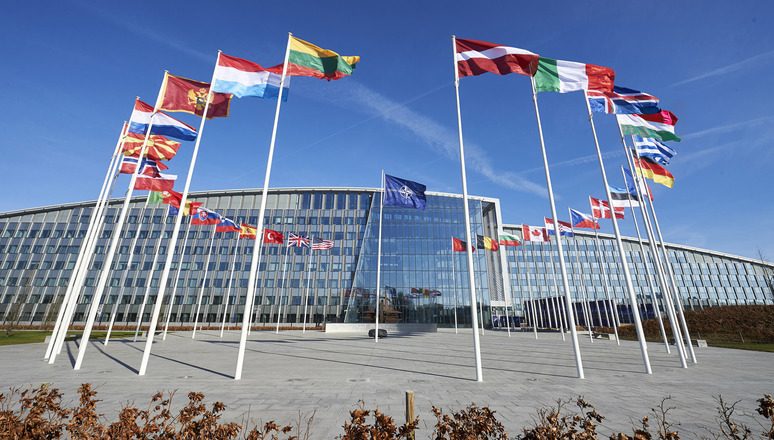NATO is a European and North American defense alliance that was created as the Cold War escalated and is headquartered in Brussels, Belgium. The aim of the alliance was to protect Western European countries from the threat posed by the Soviet Union and to counter the spread of Communism after World War II.
At present, NATO has 30 members. In 1949, there were 12 founding members of the Alliance: Belgium, Canada, Denmark, France, Iceland, Italy, Luxembourg, the Netherlands, Norway, Portugal, the United Kingdom and the United States. The other member countries are: Greece and Turkey (1952), Germany (1955), Spain (1982), the Czech Republic, Hungary and Poland (1999), Bulgaria, Estonia, Latvia, Lithuania, Romania, Slovakia and Slovenia (2004), Albania and Croatia (2009), Montenegro (2017) and North Macedonia (2020).
10 things you need to know about NATO
- Collective defence: The North Atlantic Treaty Organization (NATO) was founded in 1949 and is a group of 30 countries from Europe and North America that exists to protect the people and territory of its members. The Alliance is founded on the principle of collective defence, meaning that if one NATO Ally is attacked, then all NATO Allies are attacked. For example, when terrorists attacked the United States on 9/11 2001, all NATO Allies stood with America as though they had also been attacked.Since 2014, NATO has implemented the biggest increase in its collective defence since the Cold War. For instance, we have now deployed four multinational battlegroups to Estonia, Latvia, Lithuania and Poland. Their purpose is not to provoke a conflict, but to prevent one.
- Managing crises around the world: Promoting stability in our neighbourhood and protecting our people at home can sometimes mean taking action further afield. In the 1990s, NATO stopped further bloodshed from occurring in Bosnia and Kosovo. Since 2003, NATO has helped to ensure that Afghanistan is no longer a safe haven for international terrorist groups. NATO has also helped to prevent piracy off the Horn of Africa and, since 2016, has helped address the refugee and migrant crisis in Europe.
- Fighting Terrorism: NATO plays an important role in fighting terrorism, contributing more than 13,000 NATO troops to train local forces in Afghanistan. NATO is also a full member of the Global Coalition to Defeat ISIS, and our AWACS surveillance aircraft continue to support the Coalition. NATO is also training Iraqi forces to better fight ISIS, and our new Intelligence Division helps us to anticipate and respond to threats. In Naples, NATO has set up a ‘Hub for the South’ to help Allies tackle the threat of terrorism.
- Working with our partners: Because threats like terrorism, piracy and cyber warfare know no borders, NATO is committed to cooperation with its global partners. That’s why we work with over 40 partner countries around the world, as well as organisations such as the United Nations, the European Union, the Organization for Security and Cooperation in Europe (OSCE) and the African Union, to spread stability and security.
- Troops and Equipment: Whenever NATO carries out a mission, individual Allies commit troops and equipment to be placed under a unified NATO command. These become known as “NATO forces.” The only military equipment that NATO owns is a fleet of AWACS (Airborne Warning and Control) surveillance aircraft. NATO is also developing a capability for Global Hawk surveillance drones.
- NATO’s Command Structure: With so many countries working together, having a clear chain of command is vital. Military and civilian personnel from all member states work together every day within NATO’s ‘Command Structure.’ This includes two top-level Strategic Commands: Allied Command Operations, based in Mons, Belgium; and Allied Command Transformation, based in Norfolk in the United States. To remain fit for purpose, the NATO Command Structure is being modernised to enable us to move forces more quickly across Europe and to keep sea lines of communication across the Atlantic free and open.
- NATO funding: Every NATO country contributes to the costs of running the Alliance. By far the Allies’ biggest contribution comes in the form of taking part in NATO-led missions and operations. For example, one country might provide fighter jets, while another provides ships, equipment or troops. NATO Allies also provide direct funding to NATO to cover the costs of NATO staff and facilities, its Command Structure and its jointly-owned equipment, like its AWACS aircraft.
- Defence Spending: At the Wales Summit in 2014, NATO Allies pledged to invest more and better in defence – to stop the cuts, move towards spending 2% of GDP on defence by 2024, and to spend 20% of that on major equipment. We are making progress. Over the last three years, European Allies and Canada have spent almost 46 billion US dollars more on defence.
- The “Open Door” Policy: The Open Door Policy is a founding principle of NATO and means that any country in the Euro-Atlantic area is free to join NATO if it is prepared to meet the standards and obligations of membership, contributes to the security of the Alliance, and shares NATO’s values of democracy, reform, and the rule of law. Since 1949, NATO’s membership has grown from 12 to 30 countries. In 2020 we welcomed North Macedonia as our 30th member of the NATO Alliance.
- Cyber Defence: Cyber-attacks are becoming more common, sophisticated and damaging, making cyber defence a top priority for NATO. In fact, NATO now recognises cyberspace as an ‘operational domain’ – just as land, sea or air. NATO helps Allies to boost their cyber defences by sharing information about threats, investing in education and training, and through exercises. NATO also has cyber defence experts that can be sent to help Allies under attack.
A global media for the latest news, entertainment, music fashion, and more.




